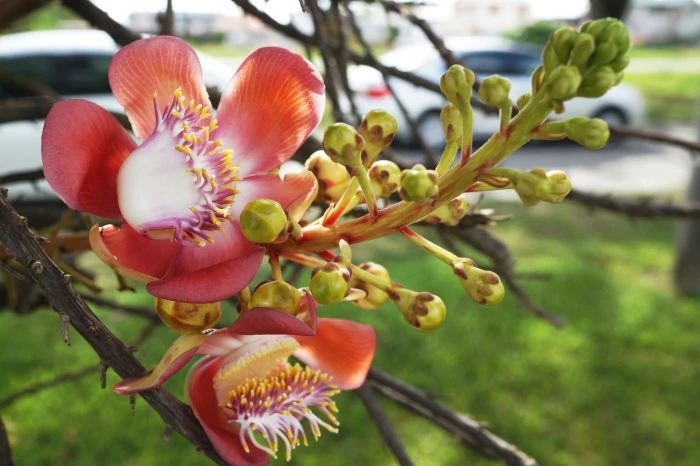Cannonball Tree
(Couroupita guianensis)
Cannonball Tree (Couroupita guianensis)
/
/

© Glynn Morris
CC BY 4.0
Image By:
© Glynn Morris
Recorded By:
Copyright:
CC BY 4.0
Copyright Notice:
Photo by: © Glynn Morris | License Type: CC BY 4.0 | License URL: http://creativecommons.org/licenses/by/4.0/ | Uploader: glynn | Publisher: iNaturalist |

























Estimated Native Range
Climate Requirements for Cypress, California
| This Plant | Your Site | Plant Suitability for Your Location | ||
|---|---|---|---|---|
| • Precipitation | 83" - 124" | 13" | Your precipitation may be insufficient for this plant. Irrigate N" / year. | Irrigate N" / year |
| • High Temp. | 84°F - 95°F | 84°F | Your summer temperatures are normal for this plant. | Excellent |
| • Low Temp. | 54°F - 72°F | 45°F | Your winter temperatures may be too cold for this plant | Too cold |
This plant should grow well at your location with about N inches per year (Y minutes per month) of irrigation.
Summary
Couroupita guianensis, commonly known as the cannonball tree, is a deciduous tropical tree native to the rainforests of Central and South America. It can reach up to 115 feet in height and is known for its large, glossy leaves and striking, fragrant flowers that range in color from pink to crimson, often with a yellow, white, or purple center. The flowers are borne directly on the trunk and larger branches, a phenomenon known as cauliflory. Flowering occurs throughout the year with peaks that vary regionally, and the flowers are considered very showy. The tree produces large, spherical fruits that resemble cannonballs, hence the common name, and these fruits are brownish-grey and can contain up to 550 seeds.
The cannonball tree is valued for its ornamental flowers and unique fruit, making it a popular choice for botanical gardens and large landscapes in tropical regions. It requires a consistently moist soil, high humidity, and full sun to partial shade to thrive. While it is not typically grown for food, the tree has cultural significance and is often planted near temples in India. Couroupita guianensis is known to have aggressive roots that can damage nearby structures, and its heavy falling fruits can pose a hazard. It is potentially invasive in some parts of the world, so it is important to check local regulations before planting.CC BY-SA 4.0
The cannonball tree is valued for its ornamental flowers and unique fruit, making it a popular choice for botanical gardens and large landscapes in tropical regions. It requires a consistently moist soil, high humidity, and full sun to partial shade to thrive. While it is not typically grown for food, the tree has cultural significance and is often planted near temples in India. Couroupita guianensis is known to have aggressive roots that can damage nearby structures, and its heavy falling fruits can pose a hazard. It is potentially invasive in some parts of the world, so it is important to check local regulations before planting.CC BY-SA 4.0
Plant Description
- Plant Type: Tree
- Height: 50-80 feet
- Width: 20-30 feet
- Growth Rate: Moderate
- Flower Color: Orange, Pink, Red
- Flowering Season: Spring, Winter
- Leaf Retention: Deciduous
Growth Requirements
- Sun: Full Sun
- Water: Medium
- Drainage: Medium, Fast
Common Uses
Bee Garden, Bird Garden, Fragrant, Showy Flowers
Natural Habitat
Rainforests of Central and South America
Other Names
Common Names: Ayahuma, Nagalingam Tree
Scientific Names: Couroupita guianensis, Couratari pedicellaris, Couroupita acreensis, Couroupita antillana, Couroupita froesii, Couroupita guianensis var. surinamensis, Couroupita idolica, Couroupita membranacea, Couroupita peruviana
GBIF Accepted Name: Couroupita guianensis